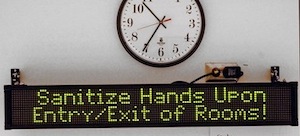 100,000 Americans die each year from hospital-acquired infections, many passed on by hospital workers from sinks and hand sanitizer dispensers inside and outside patient rooms. Infections affect one of every 20 hospital patients. The cost of treating hospital-acquired infections (including non-fatal infections) is estimated at $28 to $45 BILLION each year.
100,000 Americans die each year from hospital-acquired infections, many passed on by hospital workers from sinks and hand sanitizer dispensers inside and outside patient rooms. Infections affect one of every 20 hospital patients. The cost of treating hospital-acquired infections (including non-fatal infections) is estimated at $28 to $45 BILLION each year.
The theoretical solution is simple: Get health care workers to wash their hands, preferably within 10 seconds of entering AND leaving a patient’s room. But easier said than done. Hospitals have tried secret shopper style monitoring but it’s labor intensive and also fallible: Behavior tends to be modified when people are aware they are being observed. One cutting-edge hospital uses a video camera to monitor when someone enters and exits patients’ rooms. The camera is tightly focused on the sinks and hand sanitizer dispensers located just inside each patient room (patients are not visible). Real-time feedback is provided and is an integral portion of the system’s success: The shift supervisor is provided with compliance rates 3 hours into the shift and at the end of the shift, and prominently-located LED signs share results with the entire staff.
One hospital was shocked when video monitoring showed its true hand hygiene compliance rate was only 6.5%, especially since its secret shopper reports had claimed 60% compliance. Installation of instant feedback video monitoring raised compliance to 80%.
Lessons?
– Sometimes the best solutions involve changing human behavior
– Sometimes the most important problems to be solved are not the most dramatic
– Be skeptical, double check all results and critical feedback
NOTE: This post is based on a November 24, 2011, New York Times article, “An Electronic Eye on Hospital Hand-Washing,” by Tina Rosenberg.
P.S.: The skeptic in me notes:
1. The article did not get into results: Did increased hand washing result in lowered infection rates?
2. There was no true independent, third-party verification of outcomes. Even the best professionals can become vested in a project and find what they are looking for.

